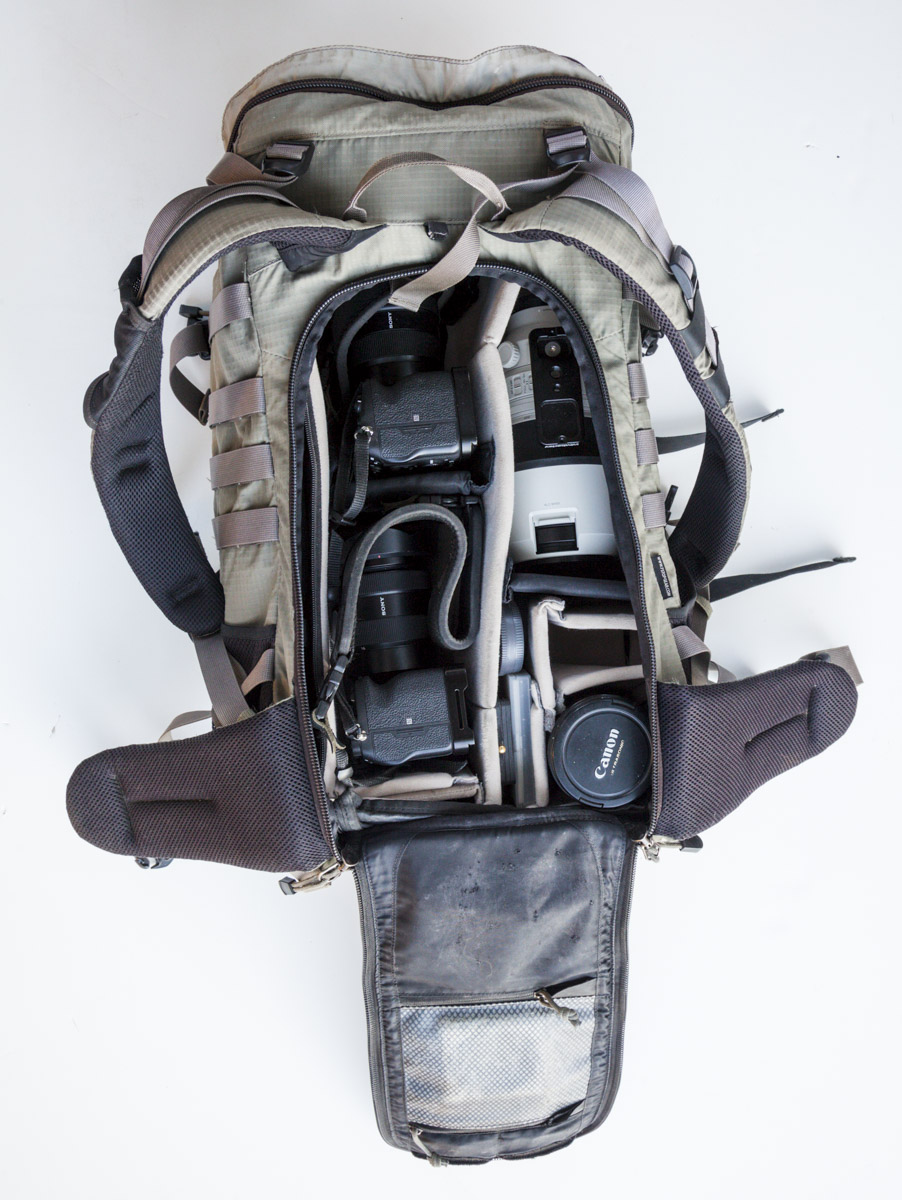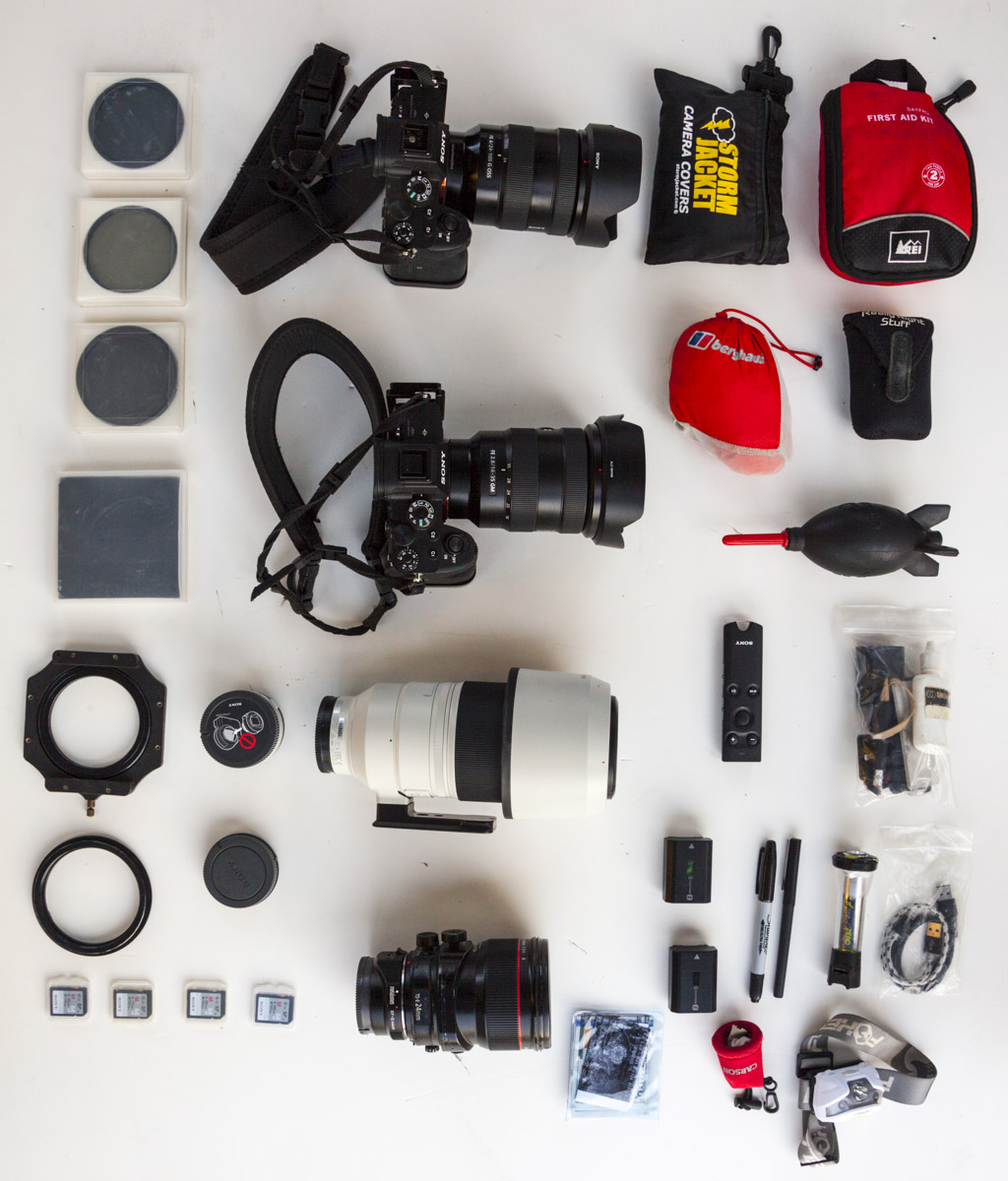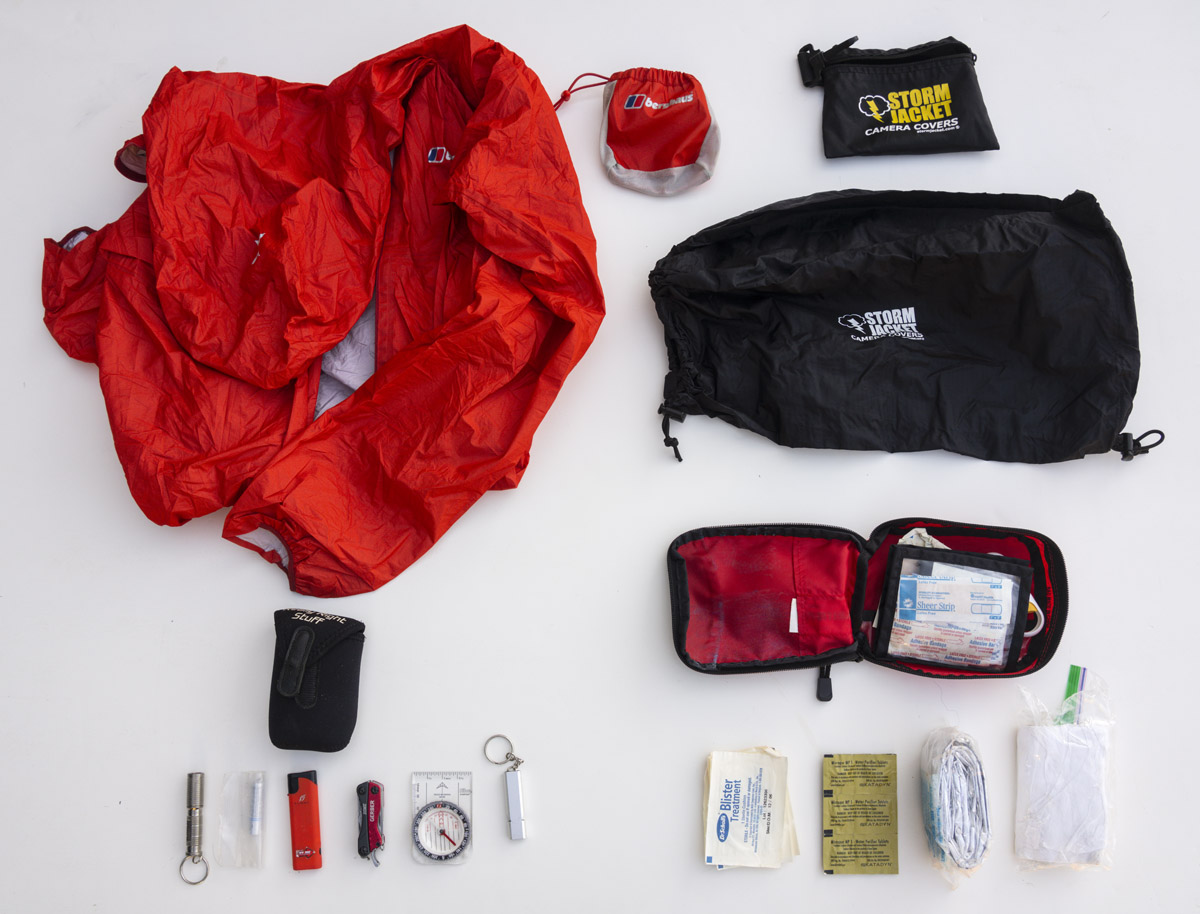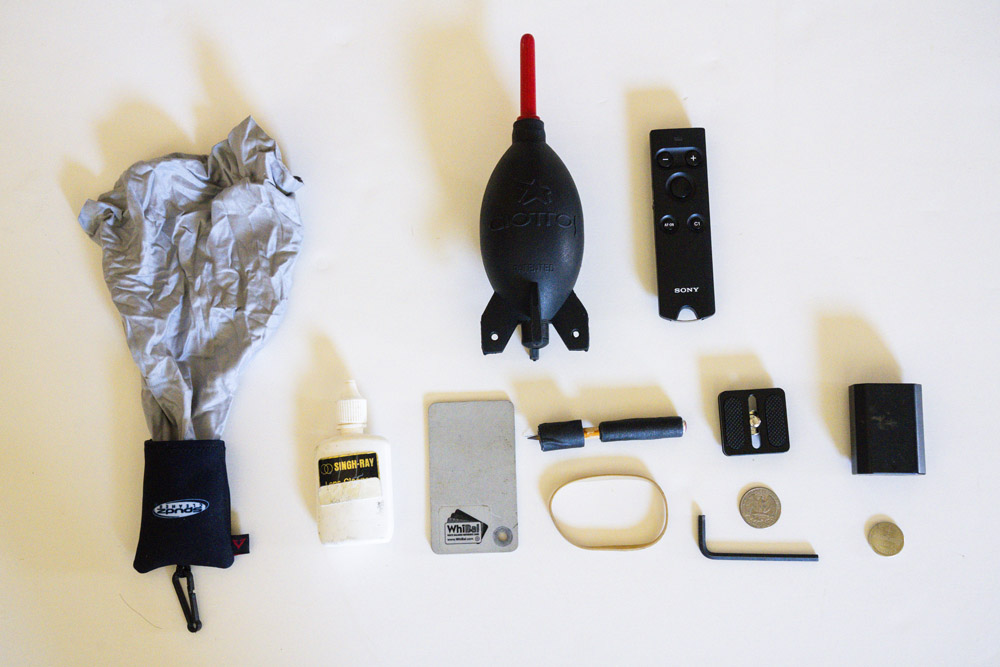Inside my General Purpose Camera bag: What I carry, Why, and How
13 Comments
Vision is better, but it can be an elusive topic to discuss or teach. On the other hand, talking shop is sure fun, and without gear, there are no photographs. In this post, I’m going to show you the gear inside my camera bag, why I selected it, and how it is organized.
This is the bag I carry for most of my outdoor photography outings as of summer 2020. I prefer to leave permanently all the accessories inside, rather than risk not having them in time of need. The weight of the bag, with all pictured equipment (including the 4 pictured lenses) is about 10.5 kg (23.5 lbs) and I break it down below by categories of equipment. Most of the time, add 2.1 kg (4.5 lbs) for camera support, plus any additional hiking/outdoor gear, food and water, for a total weight in the 13.5-18 kg (30-40 lbs) range.
F-stop Satori Bag
I’ve been using the F-stop Satori as my main camera bag since 2014. Back then, at 62 liters, it was the largest bag they made. It is now discontinued and falls between their current Tilopa (50 liters) and Sukha (70 liters) models. Before the Satori, I tried the Tilopa. While my photo gear fit, I found it too cramped to also carry outdoor gear for a day-long hike. Desert hikes require 2 or 3 quarts of water alone. F-stop was gracious enough to authorize an exchange. In the current line, the Sukha would be my choice. If the top and front pockets are not loaded, the Satori barely meets U.S. airline requirements for carry-on, but I don’t know about the Sukha. F-stop bags had two novel features, since then much copied: they open on the side you wear, and you can easily swap different internal carrying units (ICU) to configure the bag. I almost always use the largest ICU, the X-large. Non-photo items like food, water, extra layers of clothing, go in the top and front pocket. Multiple attachment points and straps on each side and on the front are for carrying tripod(s), umbrella, hiking poles, and sometimes camping gear. At about 1,950 grams without ICU, it is not exactly a lightweight bag, but the weight is acceptable given its carrying comfort and versatility.

ICU
I’ve configured the ICU so that I can carry two camera bodies with lens attached, including the largest I use (the 100-400) and this leaves room for three more lenses in addition to the two attached to the cameras. In doing so, I have prioritized quick operation, such as not having to change lenses or reverse hoods, over the capacity to carry the maximum of gear. The bag is heavy enough as is! While traveling by air, I can still cram a lot of equipment to carry-on. Here is what always goes inside the ICU (7,250 grams with 24 TSE):- Two Sony A7R4 cameras, with Arca-compatible L-plate and neoprene straps. I switched from Canon to Sony in 2015 for image quality, innovation, and mirrorless. I prefer to use two bodies to minimize lens changes, because Sony mirrorless cameras are very susceptible to sensor dust and lack effective dust removal. Also, my A7R2s were capricious, and I’ve had on more than one occasion a camera go on strike for a few days without notice. Carrying a second body provides peace of mind.
- Sony 24-105mm f/4, hood. My bread-and-butter lens, versatile and sharp, is used for more than half of my images, and I suppose in a pinch I could limit myself to just this lens. The 70-105mm range is much more useful to me than a faster lens, which is also heavier. The only drawback is excessive vignetting at 24mm (Review).
- Sony 16-35mm f/2.8, hood. Very sharp up to 24mm, it is wide and fast enough for night astro-landscape photography and accepts filters unlike the wider zooms.
- Sony 100-400mm f/4.5-5.6, hood and Arca-compatible replacement foot – tripod color greatly helps in windy conditions. Sharp over the entire focal range. Again, the 400mm reach is much more useful to me than a faster lens.
- Sony 1.4x teleconverter for the 100-400. Worth carrying despite infrequent use because it is so small.
- 4-inch square ND filters: 10 f-stop ND (Lee) and 4 f-stop (Hitech). Mostly for long exposures of water. The Lee Big Stopper has a cold color cast, but that is easily neutralized in processing.
- Lee 4-inch square filter holder, with 77mm and 82mm adapter rings for using the above.
- Extra rear lens cap and body cap.
- Canon 24mm TSE f/3.5 lens with Metabones adapter (pictured). I almost always carry it both for its ability to preserve the parallelism of parallel lines by shift (perspective correction in processing degrades image quality and alters composition) and to extend the apparent depth of field by tilt.
- Venus Laowa 15mm/f2 This manual focus/aperture lens is the best compromise for astro-landscape photography. Sharp, almost as fast and much smaller/lighter than the Sigma 14/1.8, reasonable coma.
- Sony Zeiss 55mm f/1.8. Extremely sharp, light and small, AF.
- Voigtlander Apo-Lanthar Macro 65mm/f2. The sharpest lens in the Sony system, even edging the 55mm f/1.8. Macro up to 0.5x makes it a better choice for nature photography. Shot wide-open, it produces shallow depth of field with sharp in-focus areas. Focus and aperture are manual, but all electronic aids are available unlike with Venus lenses. My main reservation is that the solid all-metal construction makes it quite heavy.

Back flap
The F-stop bag flap pockets are rather small, they have just enough room for filters and SD cards (180 grams):- Extra 64MB memory cards. Unlike Lexar, the Sony cards have a low failure rate. My main cards are the Tough G series, which are the fastest cards. I also carry M series, which are slower, but rarely need to use them on trips of less than a week. For me 64MB is a compromise between not having to manage too many cards and not having too many eggs in the same basket. With shooting split between two cameras, it lasts me a week.
- Firecrest ultra slim 77mm polarizing filter to minimize vignetting on the Sony 24-105.
- Hoya Pro1 77mm polarizing filter (for the 100-400 and TSE lenses)
- Hoya Pro1 82mm polarizing filter (for the 17-35). I store all filters in plastic B&W filter boxes.
Main Compartment Side
On the left of the ICU, there is a bit of space meant for a water bladder. Instead, I use it to store emergency/weather outdoor gear that stays there permanently (600 grams).- Generic first aid kit (REI), to which I have added: toilet paper, foil survival blanket, water purification pills, various medical pills, blister treatment.
- Emergency kit in a small (RSS) neoprene pouch: Mini multi-tool (Gerber Dime, 12 tools), loud whistle, lighter, navigation-grade compass, flashlight with spare battery (outputting 132 lumens, the Titanium Innovations CA1-TI is very bright for its size and weight).
- Ultralight shell jacket: Berghaus Hyper 100 is the lightest waterproof/breathable 3-layer hooded jacket made, it weighs an incredible 125 grams and packs very small. On a sunny summer day, although wise, it always felt overkill to pack my other mountaineering-grade jacket. Now I don’t have to think about it, as I always leave it in the bag. Tip: if you buy one, order a size up your normal size.
- Storm Jacket camera cover. I use it mainly when leaving the camera out for a night time-lapse, against condensation or unexpected rain. Its 80 grams puts in perspective the weight of the jacket.

Main compartment top
The X-Large ICU takes most of the main compartment, so there is not much room left there. I store the following camera accessories (300g):- Accessory kit in ziplock: lens cleaner fluid, extra microfiber cloth, quarter, allen wrench, square Arca plate, gaffer tape (similar to duct tape, but removable) wrapped around pen, rubber band, white balance spectrally neutral card, CR2025 battery, emergency camera battery.
- Giottos large rocket air blaster: useful not only for cleaning sensor and lenses, but also getting water droplets out of the front element. Worth the bulk, as the smaller sizes do not deliver a blast strong enough.
- Sony wireless remote commander: connect by Bluetooth so no need for cable, more reliable than IR and works from a reasonable distance. It stays paired so it is ready to use. Thankfully, A7R4s have a built-in intervalometer.

Lid pocket
I carry food and small pieces of clothing (like hat and gloves) in the lid. I use its pocket for general-purpose equipment (205 grams) and batteries (160 grams).- Goal Zero Lighthouse Micro Charge. A most versatile small piece of equipment, it serves as a flashlight or lantern with adjustable light levels, and a phone charger (More details).
- Rechargeable headlamp. There are quite a few lights in my kit since when heading out in the afternoon, I invariably seem to come back after dark. Besides hurting myself, my biggest risk is to get lost at night.
- Short micro-USB and Apple mobile cables (in Ziplock).
- Sharpie and pen.
- Microfiber cloth. It is useful to have more than one, as in rainy weather they quickly get saturated with water after wiping lenses.
- 2 camera batteries. Sony OEM batteries are 2-3 times more expensive than third party batteries but alleviate compatibility concerns and warning messages.
- Photo IDs, cash, credit card in ziplock.


Nice kit. Why the 16-35mm f/2.8 versus the 12-24mm f4? What tripod do you carry? Thank you.
With the 2.8 speed, the 16-35 f/2.8 doubles as a night lens when I don’t want to carry the 15/2. I don’t shoot superwide much by day, as I usually prefer a more natural perspective, on the other hand, a bit of overlap at 24mm is useful, esp. since the 24-105 vignettes so much at that focal length. I like to be able to use reasonably sized filters (I had an oversize filter system for the 14-24 f/2.8, it took too much room). I have several tripods ranging from series 1 to 3, and this may be the subject of another post, but for many years I mostly use a series 2 with 3 sections, currently the Induro CLT203.
Hi QT,
Any thoughts about going back to Canon now that they are back
in the full frame mirrorless game?
Pros and cons?
Thanks for the great overview of your gear!
I sold most of my Canon gear, except for things with no equivalent like the T&S lenses. It is just too expensive and time-consuming to switch systems. Previously, I used Canon for more than 15 years. I’m also not convinced that Canon’s sensors have reached the same dynamic range as Sony’s. Many of the issues in the A7R2 (battery life, AF, dual slot, EVF, lens system, missing functions) are now fixed, so it looks like Sony is listening and moving in the right direction. Canon had superior ergonomics, reliability, and dust control (but that was DSLRs).
QT – Thanks for sharing this in-depth review of the gear you carry. Many may not realize it, but a list like this takes literally years to develop and refine. I’m sure you’ve constantly thought of small changes for the better that add up to a big improvement compared to where this list probably started. I know that I’ve been through that very experience. Frank
You are right, there were many small refinements. That said, the same 3 lenses combination has been my mainstay for more than a decade.
QT,
You imply that this is your main bag and that you carry it everywhere. It seems to me that it’s fine for an all day exploration but rather a lot for a shorter hike or more focused exploration. Do you create subsets for for those occasions, and if so, how do you carry them and what are they?
(of course, you’re probably in better shape than I am to carry that all the time 🙂 ).
thanks,
-eric
Isn’t it the case that the shorter the hike, the easier it is carry a lot? I do have a subset, but it is for tougher hikes. However, the issue you mention presents itself when parking the car for a quick roadside shot. It is sometimes the case that I grab only one camera with the lens I thought appropriate for the shot as visualized while driving, and that once I’ve strolled to the viewpoint, I realize that another lens would be useful. In those situations, in order not to have to deal a backpack, I may stuff quickly one or two lenses in a hip/shoulder bag.
Greetings,
Thank you for your article on What I carry. Was interested in replacing rain jacket and noticed use you a Berghaus Hyper 100. Doing a search was not able to locate a firm in the US which sells it. Did you purchase it domestically or order it from the manufacturer?
Many thanks,
Dave
Berghaus is well-respected in European mountaineering circles, but unfortunately without much of a reach in the US. I used the EU website https://www.trekkinn.com/ Shipping can take a while, but so far appears reliable.
QT,
Many thanks for the reply. The website you mentioned no longer carries that model. If anyone else asks it is still available at the manufacturers site
https://www.berghaus.com/mens-hyper-100-jacket/422015.html
Dave
Hi QT,
At some point you replaced 5X7 film to digital gears.
Did you ever write about the decision making process? Perhaps in one of your earlier blogs that I can read about?
Is there’s anything you miss from the analogue process and ultimate image quality?
Thanks,
Dan
Hi Dan, that is an excellent question. I have partly discussed film v. digital at https://www.terragalleria.com/blog/white-sands-dusk-film-versus-digital/ but I realize that I have not discussed my personal choices, that is a subject for an entire post rather than a quick reply here!